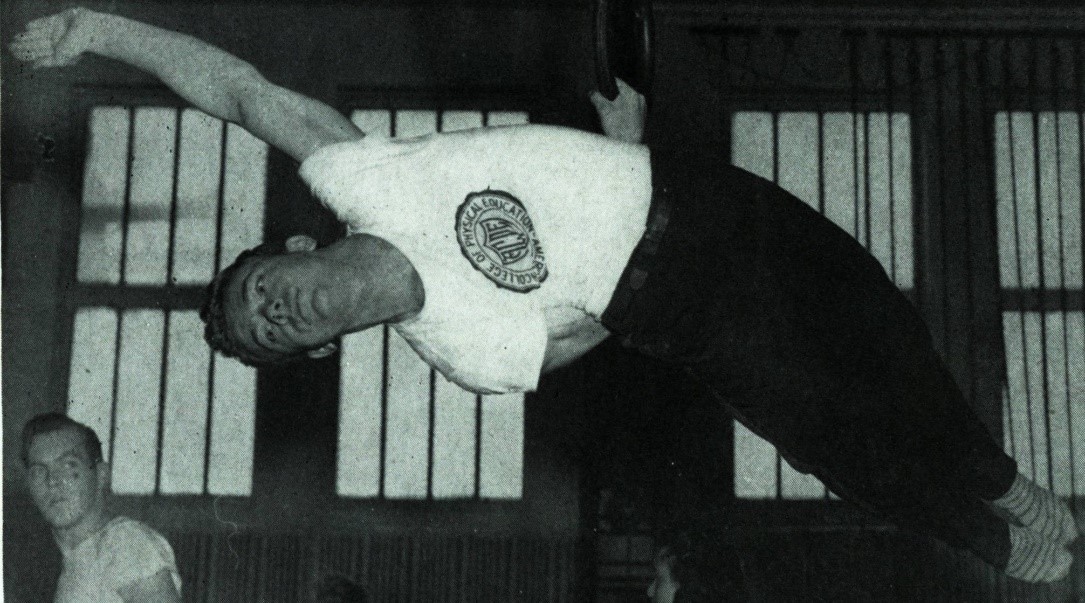The New Year brings an opportunity to reflect on the past and look to the future. Often times, people set goals to improve their physical well-being in some way, resolving to exercise more or eat healthier. This January, DePaul’s Special Collections and Archives reflect on the history of physical education at DePaul—and perhaps provides a bit of motivation for those who have set goals for a healthier lifestyle in 2020.
On March 14, 1946, a few DePaul administrators sat down to lunch with the president of the American College of Physical Education to discuss a potential collaboration. Both parties were looking to fulfil a need with such an arrangement.
A technical training school, the ACPE had specialized in physical education courses for almost 40 years. Its graduates often became certified physical education teachers in Chicago public schools and it offered credit courses for current schoolteachers. The college occupied leased facilities in Lincoln Park including one of the largest gymnasiums in the city, with a swimming pool, apparatus, boxing and wrestling rooms, and a 1,500-seat auditorium. The school was limited in its academic course offerings, however, and lacked the space for holding such classes. Charles O. Carlstrom, the president of the college, knew the ACPE’s future was limited, unless it could expand its academic offerings while continuing to offer the same high quality of physical education.
DePaul, on the other hand, was facing its own challenges of growth. Enrollments had skyrocketed post-war because of the G.I. Bill, and many of the veterans enrolled at the university had developed an interest in physical training during their service. At the time, DePaul offered a bachelor of science in health and physical education, which included some practical physical education courses like gymnastics, football, and track and field. However, students wanted a more robust physical education program from the university.
It was under these circumstances the ACPE and DePaul came to a mutual agreement to merge the two schools. Administrators decided Carlstrom would remain head of physical education, and the ACPE would continue its name. And so the American College of Physical Education of DePaul University presented its first bulletin of courses for a four-year degree in physical education at the start of the 1947-48 school year. Courses on subjects like philosophy, religion and economics were held at DePaul, while the physical education work took place at the ACPE’s facilities, located about a 10-minute walk away at 1019 Diversey Parkway.
 A physical education student practicing on the rings in 1948. (Image courtesy of Special Collections and Archives)
A physical education student practicing on the rings in 1948. (Image courtesy of Special Collections and Archives)
Over the next several years, students who divided their time between the two locations became known for their spirit and energy, affectionately referred to as DePaul’s “Diversey Demons.” The merged program developed to include a number of extra-curricular activities. An open dance was held each year, where students could showcase their modern, folk, social and tap dance abilities. There also were also annual gymnastics demonstrations, assemblies of shows put on by each class, and track and field days. At the end of each academic year, one outstanding senior student was awarded a cup for “proven scholastics, extra-curricular activities and, in general, a sincere interest in the school and its functions.”
The physical education students did eventually outgrow their Diversey Parkway facilities. In 1956 the university welcomed them to a just-completed Alumni Hall. This new, university-owned building offered the physical education students a modern swimming pool and gymnasium, exercise and class space, a 5,240-seat auditorium and a home base at DePaul.
Following its move to Alumni Hall, the physical education program progressed even more. Its students succeeded in developing another annual tradition—“Play-day.” The event invited students from local high schools to compete in athletic activities at Alumni Hall, with top performers winning trophies. After the high school competitions, DePaul gymnasts would take the floor to present, with musical accompaniment from the ROTC band. The annual event attracted hundreds of high school students from a variety of public and private schools in the area.
Over the decades, the physical education program at DePaul has changed locations and updated course offerings many times over. The Ray Meyer Fitness Center has replaced Alumni Hall’s facilities. Students majoring in physical education in the College of Education still take classes like swimming, gymnastics and folk dance, but the curriculum has evolved to include courses on the psycho-social aspects of exercise. Though it may look a bit different now than it did in 1947, the program has always been dedicated to teaching the theoretical principles alongside the practical physical skills needed to succeed in the field.